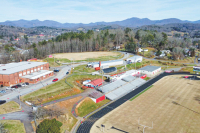Town will be forced to make adjustments
Waynesville’s residents have long reaped the benefits of the town’s electricity enterprise — a sideline business that was making $1.2 million a year.
The money paid for the Waynesville Recreation Center — a $6.5 million fitness center with indoor pool, gym and weight and workout rooms. And when talk of a downtown parking deck came up, town leaders pledged $2.5 million toward its construction, thanks to electricity revenue.
“The profits from the electric system have been used to provide a number of public facilities and improvements we would not otherwise been able to do, or we would have had to tax a lot higher in order to be able to do,” Town Manager Lee Galloway said.
But the perks seem to be on the way out. The profit from the electricity business — which despite its $1.2 million profit for the town still boasted some of the cheapest power in the state for customers — declined by nearly half last year. This year, power revenue will be only a third of the nest egg it once provided.
The reason is the rising cost of natural gas, coal and oil. The town buys power wholesale from Progress Energy and resells it to town residents. But Progress Energy has been jacking up its price on energy almost monthly.
“Everything has gone through the roof,” said Kevin O’Donnell, an energy consultant with a Raleigh-based firm Nova. “The town of Waynesville did eat some of that fuel increase.”
Related Items
When the energy costs first jumped in the summer of 2004, the town thought it was an anomaly. By fall, the energy costs were still rising, and the spread between the wholesale cost the town paid and the retail price they charged was shrinking.
“The finance director came to me and said, ‘You know we are kind of seeing a trend here. It is not just a one-time thing, apparently,’” Galloway said. “We started doing some research and found the cost of natural gas and the cost of coal were both on the rise, and that is what they primarily use to produce their energy.”
In response, town leaders were forced to hike power rates. But it was too late to recoup lost revenue from the previous six months. The town has raised rates three times in the past year, but their cost always seemed to rise faster.
“The rate increase we had used wasn’t high enough to cover it,” Galloway said “By the time we adjust our rates, the costs keep going up and we can never catch up.”
As a result, the town hasn’t been able to pay for the parking deck with revenue from its electric business after all, and is dipping into the general budget to pay off its $2.5 million contribution.
Alderman Gavin Brown said the town has become addicted to the extra revenue over the years.
“That’s one of the issues we simply have to face. We have to free ourselves from the shackles of electric revenue,” Brown said.
Brown said only making $600,000 instead of $1.2 million is still a pretty good return. The challenge is to keep the margin from slipping even more by constantly adjusting the town’s rates based on the fluctuating wholesale rates.
“If you don’t watch it constantly, you are going to wake up one day and wish you weren’t asleep at the wheel,” Brown said.









